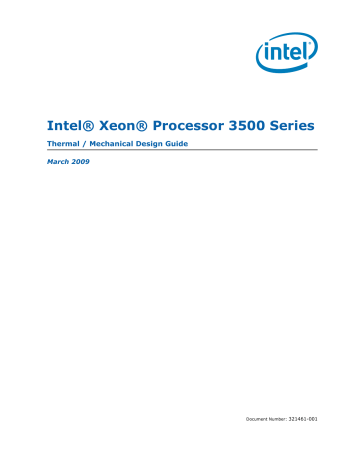- Computers & electronics
- Computer components
- System components
- Processors
- Intel
- Xeon 3500 Series
- User manual
advertisement

Sensor Based Thermal Specification Design Guidance
Figure 5-5. Thermal Solution Performance vs. Fan Speed
Note:
5.4
0.50
5.9
0.40
5.4
4.9
0.30
4.4
3.9
0.20
3.4
2.9
0.10
2.4
0.00
600 1100 1600 2100 2600 3100 3600
1.9
RPM
Psi-ca System (BA)
This data is taken from the validation of the RCBF5 reference processor thermal solution. The Ψ
CA
vs. RPM data is available in
Table 5-1 at the end of this chapter.
Fan Speed Control (FSC) Design Process
The next step is to incorporate the thermal solution characterization data into the algorithms for the device controlling the fans.
As a reminder, the requirements are:
• When the DTS value is at or below T
CONTROL with prior processors.
, the fans can be slowed down; just as
• When DTS is above T
CONTROL
, FSC algorithms will use knowledge of T
AMBIENT
and
Ψ
CA
vs. RPM to achieve the necessary level of cooling.
This chapter discusses two implementations. The first is a FSC system that is not provided the T
AMBIENT current T
AMBIENT
information and a FSC system that is provided data on the
. Either method will result in a thermally compliant solution and some acoustic benefit by operating the processor closer to the thermal profile. But only the
T
AMBIENT
aware FSC system can fully use the specification for optimized acoustic performance.
In the development of the FSC algorithm it should be noted that the T
AMBIENT
is expected to change at significantly slower rate than the DTS value. The DTS value will be driven by the workload on the processor and the thermal solution will be required to respond to this much more rapidly than the changes in T
AMBIENT
.
An additional consideration in establishing the fan speed curves is to account for the thermal interface material performance degradation over time.
Thermal/Mechanical Design Guide 33
advertisement
* Your assessment is very important for improving the workof artificial intelligence, which forms the content of this project
Related manuals
advertisement
Table of contents
- 7 Introduction
- 8 References
- 8 Definition of Terms
- 11 LGA1366 Socket
- 13 Board Layout
- 14 Attachment to Motherboard
- 14 Socket Components
- 14 Socket Body Housing
- 14 Solder Balls
- 15 Contacts
- 15 Pick and Place Cover
- 16 Package Installation / Removal
- 16 Socket Standoffs and Package Seating Plane
- 17 Durability
- 17 Markings
- 17 Component Insertion Forces
- 17 Socket Size
- 18 LGA1366 Socket NCTF Solder Joints
- 19 Independent Loading Mechanism (ILM)
- 19 Design Concept
- 19 ILM Cover Assembly Design Overview
- 20 ILM Back Plate Design Overview
- 20 Assembly of ILM to a Motherboard
- 23 Component Mass
- 23 Package/Socket Stackup Height
- 23 Socket Maximum Temperature
- 24 Loading Specifications
- 24 Electrical Requirements
- 25 Environmental Requirements
- 27 Sensor Based Thermal Specification Design Guidance
- 27 Sensor Based Specification Overview
- 28 Sensor Based Thermal Specification
- 28 TTV Thermal Profile
- 29 Specification When DTS value is Greater than TCONTROL
- 30 Thermal Solution Design Process
- 30 Boundary Condition Definition
- 31 Thermal Design and Modelling
- 32 Thermal Solution Validation
- 33 Fan Speed Control (FSC) Design Process
- 34 Fan Speed Control Algorithm without TAMBIENT Data
- 35 Fan Speed Control Algorithm with TAMBIENT Data
- 36 System Validation
- 37 Specification for Operation Where Digital Thermal Sensor Exceeds TCONTROL
- 39 ATX Reference Thermal Solution
- 39 Operating Environment
- 40 Heatsink Thermal Solution Assembly
- 41 Reference ATX Thermal Mechanical Design
- 42 Reference Design Components